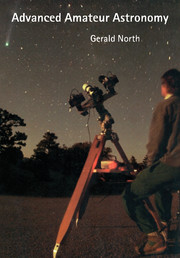Book contents
- Frontmatter
- Contents
- Preface to the second edition
- Preface to the first edition
- Acknowledgements
- 1 Telescope optics
- 2 Atmosphere, seeing, magnification and eyepieces
- 3 Telescope hardware and adjustments
- 4 Astrophotography with the camera
- 5 Astrophotography through the telescope
- 6 Electronic imaging
- 7 The Moon
- 8 The terrestrial planets
- 9 The gas-giant planets
- 10 Asteroids, comets, meteors and aurorae
- 11 The Sun
- 12 Variable stars and novae
- 13 Methods of photometry
- 14 Double stars, star clusters, nebulae, galaxies and supernovae
- 15 Spectroscopy
- 16 Radio astronomy
- 17 Further information
- Appendix: Useful formulae
- Index
- Frontmatter
- Contents
- Preface to the second edition
- Preface to the first edition
- Acknowledgements
- 1 Telescope optics
- 2 Atmosphere, seeing, magnification and eyepieces
- 3 Telescope hardware and adjustments
- 4 Astrophotography with the camera
- 5 Astrophotography through the telescope
- 6 Electronic imaging
- 7 The Moon
- 8 The terrestrial planets
- 9 The gas-giant planets
- 10 Asteroids, comets, meteors and aurorae
- 11 The Sun
- 12 Variable stars and novae
- 13 Methods of photometry
- 14 Double stars, star clusters, nebulae, galaxies and supernovae
- 15 Spectroscopy
- 16 Radio astronomy
- 17 Further information
- Appendix: Useful formulae
- Index
Summary
This is a book on advanced techniques in amateur astronomy, not a textbook on optics. However, the amateur astronomer should understand the basics of optical theory as applied to telescopes. How else might he/she make sensible choices as to the equipment to be purchased or constructed? The characteristics and performance of the telescope and its auxiliary equipment depend heavily on design. Aperture, focal length, focal ratio, image scale, resolving power, image brightness, image contrast, magnification and diffraction pattern structure are just some of the interrelated factors of crucial importance. The purpose of this chapter is to provide a summary of the optical matters relevant to the needs of the telescope user.
Focal length and image scale
Before considering specific types of telescopes let us take the imaginary case of a single, perfect, converging lens forming an image of a distant object. Further, imagine that the object is a point source, such as a star. With reference to Figure 1.1(a), the rays from the star will arrive at the lens virtually parallel. The line perpendicular to the plane of the lens and passing through its centre is known as the optical axis. If, as is shown in the diagram, the optical axis of the lens is aligned in the direction of the star, then all the arriving rays will be parallel to the optical axis.
If the lens is truly perfect then all the rays from the star will be brought together at a common point after passing through the lens.
- Type
- Chapter
- Information
- Advanced Amateur Astronomy , pp. 1 - 26Publisher: Cambridge University PressPrint publication year: 1997



